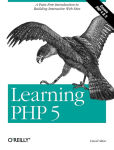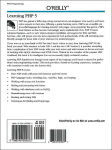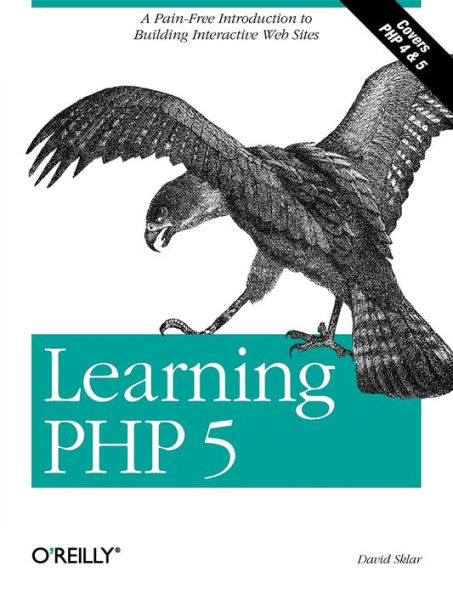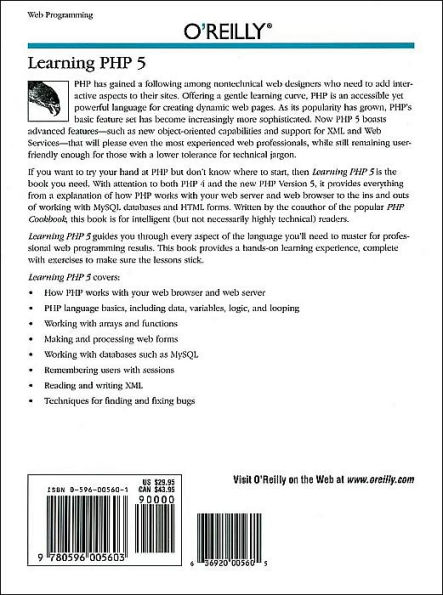Learning PHP 5
PHP has gained a following among non-technical web designers who need to add interactive aspects to their sites. Offering a gentle learning curve, PHP is an accessible yet powerful language for creating dynamic web pages. As its popularity has grown, PHP's basic feature set has become increasingly more sophisticated. Now PHP 5 boasts advanced features—such as new object-oriented capabilities and support for XML and Web Services—that will please even the most experienced web professionals while still remaining user-friendly enough for those with a lower tolerance for technical jargon. If you've wanted to try your hand at PHP but haven't known where to start, then Learning PHP 5 is the book you need. If you've wanted to try your hand at PHP but haven't known where to start, then Learning PHP 5 is the book you need. With attention to both PHP 4 and the new PHP version 5, it provides everything from a explanation of how PHP works with your web server and web browser to the ins and outs of working with databases and HTML forms. Written by the co-author of the popular PHP Cookbook, this book is for intelligent (but not necessarily highly-technical) readers. Learning PHP 5 guides you through every aspect of the language you'll need to master for professional web programming results. This book provides a hands-on learning experience complete with exercises to make sure the lessons stick. Learning PHP 5 covers the following topics, and more:
1100352523
- How PHP works with your web browser and web server
- PHP language basics, including data, variables, logic and looping
- Working with arrays and functions
- Making web forms
- Working with databases like MySQL
- Remembering users with sessions
- Parsing and generating XML
- Debugging
Learning PHP 5
PHP has gained a following among non-technical web designers who need to add interactive aspects to their sites. Offering a gentle learning curve, PHP is an accessible yet powerful language for creating dynamic web pages. As its popularity has grown, PHP's basic feature set has become increasingly more sophisticated. Now PHP 5 boasts advanced features—such as new object-oriented capabilities and support for XML and Web Services—that will please even the most experienced web professionals while still remaining user-friendly enough for those with a lower tolerance for technical jargon. If you've wanted to try your hand at PHP but haven't known where to start, then Learning PHP 5 is the book you need. If you've wanted to try your hand at PHP but haven't known where to start, then Learning PHP 5 is the book you need. With attention to both PHP 4 and the new PHP version 5, it provides everything from a explanation of how PHP works with your web server and web browser to the ins and outs of working with databases and HTML forms. Written by the co-author of the popular PHP Cookbook, this book is for intelligent (but not necessarily highly-technical) readers. Learning PHP 5 guides you through every aspect of the language you'll need to master for professional web programming results. This book provides a hands-on learning experience complete with exercises to make sure the lessons stick. Learning PHP 5 covers the following topics, and more:
- How PHP works with your web browser and web server
- PHP language basics, including data, variables, logic and looping
- Working with arrays and functions
- Making web forms
- Working with databases like MySQL
- Remembering users with sessions
- Parsing and generating XML
- Debugging
29.95
In Stock
5
1

Learning PHP 5
368
Learning PHP 5
368Paperback(First Edition)
$29.95
29.95
In Stock

Product Details
| ISBN-13: | 9780596005603 |
|---|---|
| Publisher: | O'Reilly Media, Incorporated |
| Publication date: | 07/02/2004 |
| Edition description: | First Edition |
| Pages: | 368 |
| Product dimensions: | 7.00(w) x 9.19(h) x 0.79(d) |
About the Author
From the B&N Reads Blog



